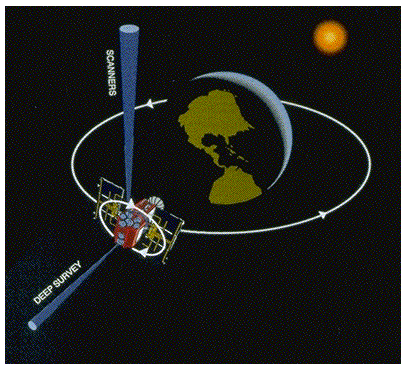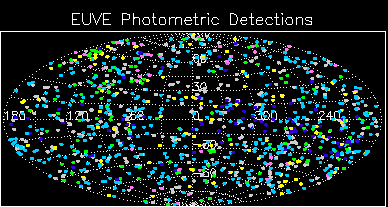|
|||||||||||||||||||
|
|
|||||||||||||||||||
|
|
EUVE All Sky Survey
The survey phase of the mission started on 24 July 1992 and concluded on 21 January 1993. There were monthly calibration pointings conducted during this phase, and so the initial survey data included gaps in the sky coverage. Short periods of gap-filling were carried out during the first six months of the GO program. The completed survey data set covers approximately 97% of the sky with exposures ranging from a few hundred seconds at the ecliptic to 20 kiloseconds at the poles.
Two different kinds of sky surveys were simultaneously conducted. The EUVE's three scanning telescopes systematically measured the positions and intensities of sources across the entire sky, while the deep survey telescope mapped faint sources along a narrow band on the Ecliptic. The survey detected 734 objects. We show an aitoff projection of EUVE sources in equatorial coordinates. Shown are nearly 1200 unique sources from the EUVE all-sky surveys and follow-up observations with the Right Angle Program (RAP). (Please click here for more information about the EUVE surveys and RAP results).
Geometry of the Survey Phase

The scanning telescopes are swept across the sky by the slowly revolving spacecraft, while the deep survey telescope is pointed down the Earth's shadow.
To conduct the all-sky survey, the EUVE slowly revolved around its axis, sweeping its three scanning telescopes in great circles across the sky. These repetitive scans, combined with the Earth's orbital motion around the Sun, allowed the scanning telescopes to map the entire celestial sphere within about six months. Utilizing four band passes, the three scanning telescopes observed the sky over the entire extreme ultraviolet range (60-740Å).
Accomplishing the deep survey, however, was more challenging. The geocoronal glow, caused by sunlight that strikes the diffuse hydrogen and helium gas atoms surrounding the Earth, makes it difficult to observe faint EUV sources. Consequently, scientists configured the mission so that the deep survey telescope always pointed away from the Sun and only took measurements while viewing down Earth's shadow - the night portion of the orbit when the Earth blocks the Sun and shields the spacecraft from sunlight. This technique made the deep survey more sensitive by a factor of ten. Utilizing two band passes, the deep survey telescope observed a portion of the extreme ultraviolet range (70-365Å).
Page created by CEA and brought to MAST 2/1/99
|
|
|




 Follow Us
Follow Us
